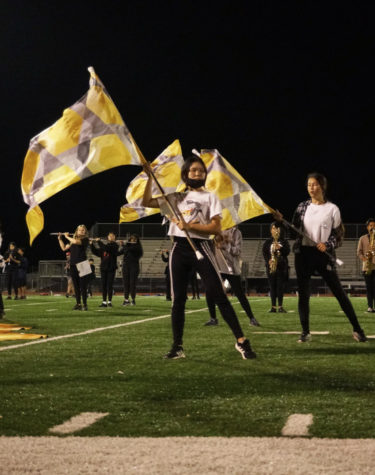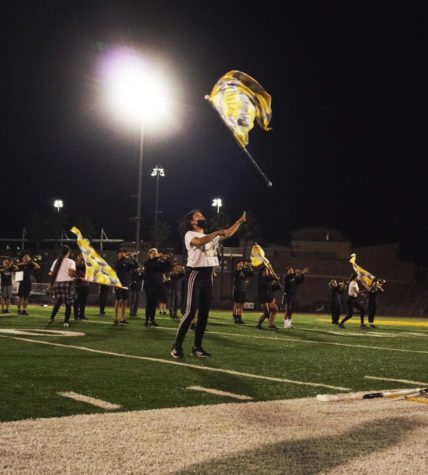Way transitions to Color Guard
October 8, 2021
Tiffany Way (12) has always been an avid flutist. Having played flute since the 5th grade, Way stuck by her woodwind of choice for what seemed like ages. So, when she stepped onto
the field she was once so familiar with, with a Color Guard flag in hand rather than a flute, Way felt anew.

Way’s interest in Color Guard started in middle school when she was invited to watch a family friend perform in GOLD’s spring show.
“Watching his performance was my first introduction to Color Guard,” Way said, “I was especially intrigued by how Color Guard combined elements of dance with the use of equipment.”
Furthermore, Way said she has had a fascination with dance for a while. Before joining Color Guard, she has been a part of the K-pop Dance Club since her freshman year and took hip hop classes in middle school.
“The way that people are able to choreograph and perform their dances or teach their dances to other has always been really cool and something I admire,” she said.
With Way’s long history of playing flute, she was naturally hesitant when deciding to leave the familiar instrument behind to pursue a new passion.
“I still enjoyed being in band and felt reluctant to leave band during high school,” she said. “At the same time, I knew that if I had the chance I would want to join Color Guard or I might regret not having tried it out.”
On top of this, Way said her status as a senior played heavily into her eventual decision to switch.
And so, through GOLD’s preparations for the upcoming marching tournament season, Way has been refining her flag technique for the past two months.
After making the transition, Way said the two roles demand different things from her in terms of technique.
“Instrumental marching is definitely more rigid than Color Guard marching,” she said. “With instruments, you really aren’t doing any excessive moving of the rest of your body while marching, but with Color Guard you have to simultaneously do the choreography, which might involve tossing the equipment, all while getting to your next dot.”
In marching band, positioning is mapped out with “dots,” or locations on the field described in relation to yard line markings. Performers are given a series of dots that instruct them where to move for each set, which is a specifically defined segment of the music.
While marching flute, Way said that counting the measures in a set while marching was a sufficient way to keep time on the field. Instrument marchers are able to sync their marching with their playing this way.

“For Color Guard marching, not just the counts of each set but also the choreography that I’m about to do runs through my head,” she said. “Something that’s been helpful in conjunction with counting out loud is knowing exactly how the choreography fits with the music so that if I accidentally lose count or mess up, I can still come back in.”
According to Way, Color Guard members segment parts of the show around choreography.
“The major difference between instrument marching and Color Guard in this aspect is that rather than thinking about the music in terms of [sets], we reference different parts of the show with what the set looks like visually—are we in a circle, running through the band—or the work that we are doing at that particular point in the show.”
Way said she finds the precision and movements required for Color Guard significantly more exhausting than instrumental marching.
“I find myself just as out of breath by the end of the first movement in guard as I did at the end of [a show] during instrumental marching,” Way said. “In my opinion, the combination of counting, doing choreography, and marching does require more precision and is much more physically exerting than instrumental marching.”
Despite her exhaustion at the end of each performance, Way said she is able to find worthwhile satisfaction alongside it.
“I’m definitely not complaining about [the physical demands] as the rush that comes with performing makes up for any fatigue that I might experience towards the end of a movement,” she said. “Color guard has been an incredibly fun and educational experience so far, and I’m thankful that I am able to be a part of a group of such talented and amazing individuals.”


